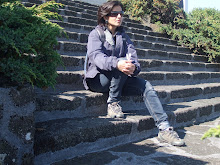 |
| One of the new houses built by the government for the Nicobari tribals. Courtesy: Prince Rasheed. |
The force of the 2004 undersea Indian Ocean earthquake was so intense that the island of Trinket split in three. Trinket is part of the Nicobar archipelago of 22 islands that belong to India. The government moved all the local Nicobari tribals to a neighbouring island but Gopinath Jeem and a few others came back because they couldn’t bear the temporary tin shelters made by the government. He says, “All the families want to come back but we were the first because we could not tolerate it there.”
Back in devastated Trinkat they have found their own fresh water source and using trees from the forest, they have built their own traditional Nicobari huts called machans.
The Nicobar archipelago is one of India’s furthest outposts. The 2004 earthquake pulverised the islands and the tsunami killed nearly a fifth of the Nicobari tribal population. Prior to the disaster the Nicobarese were primarily a hunter-gatherer tribe living in large joint families in a close-knit societal structure called a tuhet. But after the tsunami there has been such a massive injection of money and new housing that their ancient way of life has changed drastically.
The Nicobar islands are closed to outsiders so the government 3000 kms away in New Delhi along with the local administration in Port Blair felt the need to step in to provide food and shelter. Samir Acharya who represented the Central Tribal Council of Nicobar in negotiations with the government on housing says, “The new houses are bad news for the Nicobarese and bad news for the islands.”
Problems began shortly after the tsunami when Nicobarese demanded tools to be able to build their own houses as they had done for decades. But the government didn’t give them the opportunity. Dr. Simronjit Singh, a senior researcher and lecturer at the Institute of Social Ecology in Austria wrote a paper titled, “Complex Disasters: The Nicobar Islands in the grip of Humanitarian Aid.” In it he criticizes the sometimes well-meaning but generally insensitive forced help given to a people who were in fact keen to help themselves. He says, “The anxiety to begin a new life and fend for themselves, despite a trauma not so long ago, reflects the resilience of the Nicobarese in the face of tragedy along with the ideology that life must go on, and singularly so, aid or no aid!”
And yet the “help” kept coming. First it was in the form of temporary shelters that the Indian Army built for the Nicobarese. They were built in haste to beat the monsoon but were made of tin and were like hot ovens during the day in the tropical heat. The Nicobarese suffered these houses for nearly four years. The National People’s Tribunal on Post-tsunami Rehabilitation declared that the government had failed in its “legal and moral responsibility of upholding the human rights and ensuring the welfare of all those affected by the tsunami.”
The Nicobarese detested the tin shelters and wanted to build their own permanent shelters but again this was thwarted. The negotiating process was bewildering for the tribals who were not used to such a heavy influence of government in their lives. However, Shakti Sinha the Chief Secretary of the Andaman and Nicobar islands says, “Maybe the process was not perfect, but it was definitely consultative.”
Prince Rasheed, a Nicobari who studied on the Indian mainland and is a spokesperson for the Tribal Council however feels that the negotiating power was so unequal, the tribals simply gave in. He said, “In the end we thought we would take the houses since the government was giving them to us for free but we are now realising that we made a bad choice. The government has built colonies.”
The house designs are creating a less personal culture. Replacing the large, wooden machans where a joint family would live, the government has built small concrete two-room houses meant for nuclear families. These new houses have also increased the community’s cost of living. For example, earlier Nicobarese did not use electricity in their machans but now many have TVs and fans in their home for which they have to pay. They have also lost the ability to fix things in their homes themselves because all the material used on the homes is exotic. Samir Acharya says, “The way these new houses are built will do very long-term damage to the social fabric of the Nicobarese.”
The Nicobarese used to be a cash poor but resource rich society unused to hoarding and saving money. After the tsunami many spent their government compensation money in a burst of consumerism buying whiskey, TVs and motorbikes. Now much of that money is spent and they are stuck without even their primary source of income from their coconut plantations which were destroyed during the tsunami. They are realising that the lifestyle imposed by the new houses is unsustainable. Prince Rasheed says, “The government’s food rations have stopped and 95% of the people are finding it hard to survive. Some people are just eating papayas and living.”
Free-spirited Gopinath Jeem would rather live in Trinkat than suffer the government shelters. He knows perfectly well how to survive on his own island without outside help. As night falls over Trinkat mosquitoes descend in droves as though the air were filled with needles but it doesn’t seem to bother him at all. He says, “We have a love for this island and we can never leave it.”
Eleven families have returned to Trinkat and built their own homes. But for the many others adapting their lives to the new houses, the government’s costly housing intervention will continue to impact their lives.

No comments:
Post a Comment